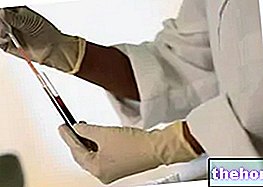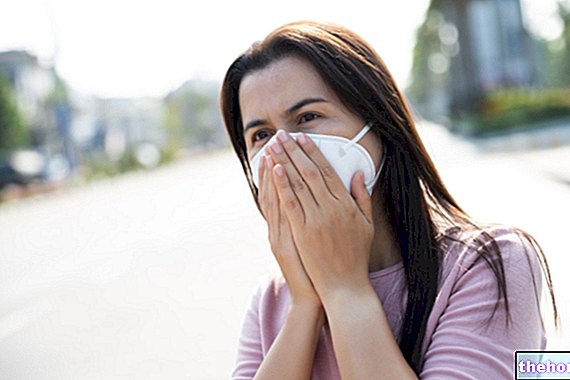Latex allergy: key points
Latex allergy is an abnormal, exaggerated and violent immune response of the body following contact or inhalation of latex particles.
Latex allergy: causes
In an extremely sensitive subject, direct contact with latex objects or simply the inhalation of some of its proteins (allergens) triggers an exaggerated immune reaction, known as a latex allergy.

In general, latex allergy triggers purely skin symptoms (urticaria, angioedema, redness, blisters, erythema), often associated with respiratory deficits (asthma, rhinitis, hypoxia, dyspnoea). Latex allergy can induce anaphylactic shock and death .
Latex allergy: diagnosis
The suspicion of latex allergy is ascertained by specific skin tests (Prick-test, Prick by prick-test, Patch-test, Finger-test, Glove-test). In vitro tests are also possible (serum search for specific IgE for latex).
Latex allergy: drugs
The best cure for latex allergy is to avoid any possible contact with latex objects. Antihistamines and corticosteroids can relieve symptoms. Injectable epinephrine is essential in case of anaphylaxis.
Introduction
Latex allergy is an exaggerated and sudden reaction of the organism to the proteins contained in natural rubber latex (latex or caoutchouc). After contact with latex-based products, the organism of an allergic person responds with a violent and acute skin and / or respiratory reaction. A particularly sensitive subject, following contact with the allergen, may also encounter to anaphylactic shock, which puts the patient's survival at serious risk.
Allergies to natural latex products have sharply increased in recent years, particularly in the healthcare sector. Latex allergies are estimated to affect 0.8-8.2% of the world population. However, not all latex allergies are symptomatic: some individuals, in fact, despite being positive in allergy tests, do not complain of any allergic symptoms.
In this article we will try to understand how and why the body triggers a latex allergy, and which categories are most at risk.
To understand...
Natural rubber latex is produced from the sap of numerous higher plants (Angiosperms): it is an extremely elastic material, which is therefore used to make gloves, condoms, mattresses, toys, carpets, sanitary napkins, syringes, surgical masks, etc. .. Latex is a milky liquid composed of a mixture of alkaloids, enzymes, proteins and hydrocarbons; the proteins most involved in latex allergies are called eveine, and take their name from the plant from which the vast majority of latex is extracted (Hevea Brasiliensis).
Causes and risk factors
CAUSES
The symptoms of latex allergy occur after an erroneous recognition of the allergen (latex proteins) by the immune system, which identifies it as a harmful substance for the body. After an occasional contact - by skin or inhalation - with products containing latex, the immune army of a sensitive individual attacks the proteins present in it; doing so triggers an exaggerated allergic reaction.
By identifying latex proteins as foreign and potentially dangerous substances, the immune system mobilizes and activates cells for the production of antibodies (IgE Immunoglobilins). In an individual allergic to latex, contact with latex proteins triggers an exaggerated inflammatory reaction, in which mast cells release large amounts of histamine.
It is observed that latex allergy tends to occur after repeated and frequent exposure / contact with natural latex products.
Please note
Not all latex objects are made with natural rubber: contact with products made with synthetic latex does not (generally) trigger similar allergic reactions. In any case, it is recommended to carefully read the composition of that particular object on the label, since many products contain a mixture of natural and synthetic latex.
RISK FACTORS
While it is not entirely clear why an individual triggers an exaggerated allergic reaction to latex, some risk factors have been identified:
- Workers in the rubber industry: continuous exposure to latex proteins exaggeratedly increases the risk of allergies. 10% of these workers develop allergies after more contact with natural latex.
- Children with spina bifida: These patients are often exposed to contact with latex products because they require frequent medical attention. Let us briefly recall that latex is a natural material that is widely used in the production of health products. It is estimated that 50-68% of children with spina bifida are also allergic to latex.
- Patients undergoing multiple surgeries: Frequent contact with latex gloves increases the chances of developing latex allergy.
- Congenital anomalies of the urinary tract: these patients too are often in contact with health products containing latex, therefore more exposed to the risk of developing allergies.
- Healthcare workers: doctors and nurses are forced into continuous contact with instruments and materials made with natural latex; therefore, even this category of subjects is at risk of developing latex allergies. It is estimated that 4-17% of healthcare workers suffer from latex allergy.
- Subjects suffering from hay fever, asthma and food allergies: this category of people is also more exposed to the risk of developing allergies to latex.
- Genetic predisposition: also in this case - for the umpteenth time - familiarity plays a decisive role in triggering allergies. Children of allergic parents are more predisposed to develop allergic reactions, including those to latex.
Allergies to latex and cross allergies
It is estimated that at least half of latex allergy sufferers are also sensitive to certain foods, especially fruit and vegetables. The most common latex-related allergies are those to nuts and bananas, but also other types of vegetables - through a mechanism of cross reactivity - can cause the same symptoms: pineapple, chestnuts, cherry, figs, strawberries, passion fruit, kiwi, apples, melon, papaya, potatoes, pears, tomatoes, turnips, etc.
The simultaneous allergy to latex and to some types of fruit is recognized with the name "latex-fruit syndrome". Some foods, in fact, contain proteins very similar to those of natural rubber, therefore, an individual allergic to latex can develop more or less important sensitizations to these foods as well.
Other articles on "Latex Allergy"
- Latex Allergy - Classification and Symptoms
- Latex Allergy - Diagnosis and Therapy
- Latex Allergy - Medicines for the treatment of Latex Allergy
- Latex Allergy Remedies
















.jpg)











